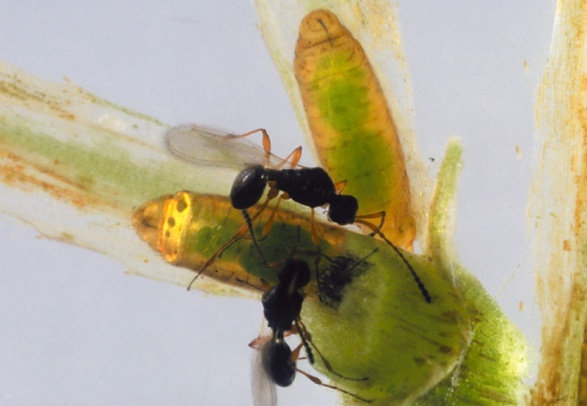
Two adults of Trichopria columbiana Ashmead parasitizing pupae of Asian hydrilla leaf mining fly
(Photographer: Lyle Buss, University of Florida)
Hydrilla leaf miner wasp
Trichopria columbiana Ashmead
(Insecta: Hymenoptera: Diapriidae)
Trichopria columbiana is a solitary endoparasitoid of shore flies of the genus Hydrellia, including the introduced Asian hydrilla leaf mining fly, Hydrellia pakistanae. It was first discovered parasitizing Hydrellia pakistanae soon after the fly was released for biological control of hydrilla in Florida, Alabama and Texas in the late 1980s.
Adults of this small (1.4 to 1.8 mm long), semiaquatic wasp are shiny black with clear wings, and predominantly female. Reproduction is unisexual; females are produced generation after generation without male intervention.
Females swim or crawl under water to locate the Hydrellia host pupa. When a suitable host is found, she inserts her ovipositor into the pupal thorax and deposits up to three eggs. The larvae hatch and undergo three instars and a pupal stage in 21 to 24 days. Wasps emerge from the hosts by cutting circular holes through the head/thorax region.
Trichopria columbiana is native to North, Central, and South America as well as Mexico and the Caribbean Islands.
A field study conducted with sentinel pupae in Alabama in 1992 showed that up to 50% mortality of Hydrellia pakistanae was caused by the wasp.
Images
To
save the Web-optimized images shown below to your hard drive:
PC users: right click to "Save Picture (or Image) As..."
Mac users: click and drag to your desktop.

Two
adults of Trichopria
columbiana
Ashmead parasitizing pupae of Asian hydrilla leaf mining
fly
(Photographer: Lyle
Buss, University of Florida)